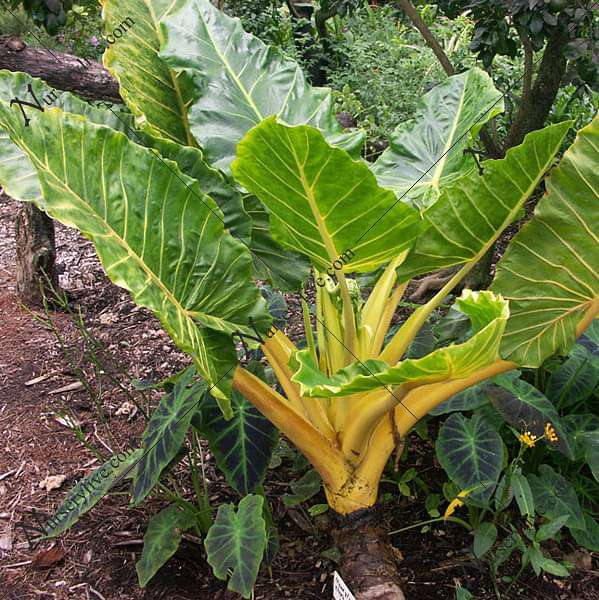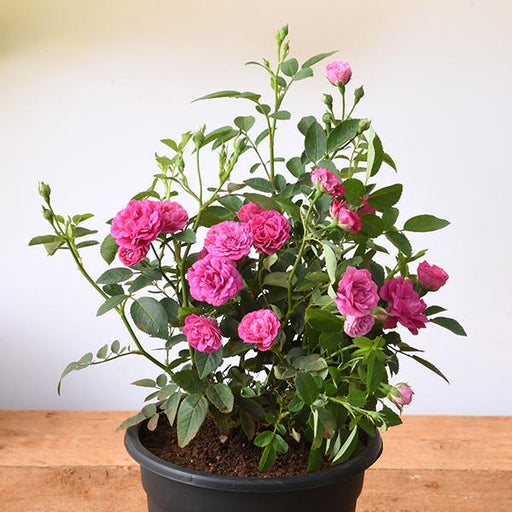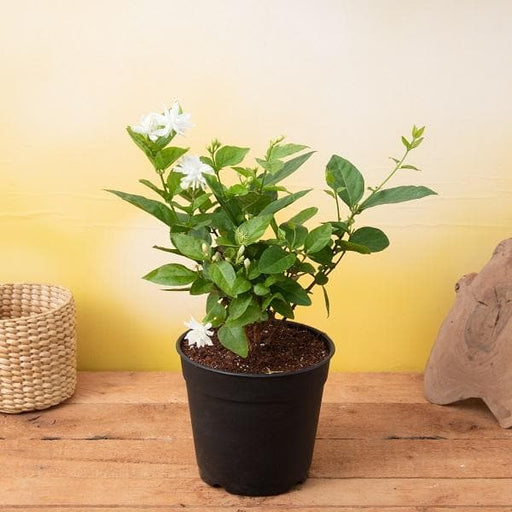
Alocasia macrorrhiza var lutea - Plant
(MRP Inclusive of all taxes)
- Shipping ₹79 for entire order
- Dispatch in 7 days
- Country of origin: India

(MRP Inclusive of all taxes)
 Save 29%
Save 29%
Air Purifier Money Plant with Pot The Air Purifier Money Plant, also known as Pothos or Epipremnum aureum, is a stunning indoor plant that...
View full details
 Save up to 15%
Save up to 15%
Peace Lily, Spathiphyllum - Plant The Peace Lily, scientifically known as Spathiphyllum, is a stunning houseplant celebrated for its elegant white...
View full details
 Save 25%
Save 25%
Jasminum sambac, Mogra, Arabian Jasmine - Plant Jasminum sambac, commonly known as Mogra or Arabian Jasmine, is a fragrant flowering plant...
View full details
 Save 18%
Save 18%
Combo Constituents Includes the Parijat Tree (Night-Flowering Jasmine), a culturally significant plant with fragrant flowers. Description The Pari...
View full details
 Save 25%
Save 25%
Miniature Rose, Button Rose (Any Color) - Plant The Miniature Rose, also known as the Button Rose, is a charming and compact flowering plant that ...
View full details Save 25%
Save 25%
Damascus Rose, Scented Rose (Any Color) - Plant The Damascus Rose, also known as Rosa damascena, is a timeless symbol of beauty and romanc...
View full details
 Save 17%
Save 17%
Beautiful Fragrant Mogra, Arabian Jasmine Plant with Pot The Beautiful Fragrant Mogra, also known as Arabian Jasmine (Jasminum sambac), is...
View full details Save 15%
Save 15%
Pack of Vermicompost and Neem Cake for House Plants Transform your indoor garden with our premium Pack of Vermicompost and Neem Cake, spec...
View full details
Pack of Plant Growth and Flower Boosters Unlock the full potential of your garden with our Pack of Plant Growth and Flower Boosters! This ...
View full details Save 38%
Save 38%
Combo of Jeevamrut and Neem Raksha for Easy Growth and Protection of Houseplants Transform your indoor garden with our exclusive combo of ...
View full details Save 22%
Save 22%
Plant Nutrients Kit (Pack of 16) for a Healthy Garden Transform your garden into a lush paradise with our Plant Nutrients Kit, featuring 1...
View full details Save 16%
Save 16%
Combo of Top Plant Fertilizers Elevate your gardening game with our exclusive Combo of Top Plant Fertilizers, featuring two bags of premiu...
View full details Save 24%
Save 24%
Pack of 4 Additives to Make Soil Healthy and Nutrient Rich Transform your garden into a thriving ecosystem with our Pack of 4 Additives de...
View full details Save 30%
Save 30%
Transform your gardening experience with our premium Combo of Perlite and Vermiculite. This unique blend is designed to enhance soil aeration and ...
View full details Save 27%
Save 27%
Combo of 2 Vermicompost and Cocopeat - Enrich Your Soil Naturally! Transform your garden into a thriving ecosystem with our Combo of 2 Ver...
View full details
 Save 35%
Save 35%
Best 6 Plants for Perfect Indoor Garden Transform your living space into a lush oasis with our curated collection of the Best 6 Plants for a...
View full details
 Save up to 50%
Save up to 50%
Mini Succulent Garden Pack Transform your space with our Mini Succulent Garden Pack, featuring a delightful collection of 4 any variety beautiful s...
View full details
 Save 30%
Save 30%
5 Best Fragrant Plants Transform your garden or indoor space into a fragrant paradise with our curated selection of the 5 Best Fragrant Plants. Th...
View full details
 Save 24%
Save 24%
Set of 2 Bonsai Looking Grafted Adeniums Transform your indoor or outdoor space with our exquisite Set of 2 Bonsai Looking Grafted Adenium...
View full details Save 45%
Save 45%
Top 4 Die Hard Succulents Pack Transform your indoor or outdoor space with our Top 4 Die Hard Succulents Pack, featuring a curated selecti...
View full details
 Save 30%
Save 30%
5 Best Indoor Plants Pack Transform your living space into a lush oasis with our '5 Best Indoor Plants Pack.' This carefully curated collection fe...
View full details
 Save 25%
Save 25%
Set of 4 Evergreen Air Purifier Plant Pack Transform your indoor space into a lush, green oasis with our Set of 4 Evergreen Air Purifier Pla...
View full details| SrNo | Item Name |
|---|---|
| 1 | Alocasia macrorrhiza var lutea - Plant |
The Alocasia macrorrhiza var lutea, commonly known as the Giant Taro or Yellow Elephant Ear, is a stunning tropical plant that captivates with its large, vibrant yellow-green leaves. Native to Southeast Asia, this perennial plant thrives in warm, humid environments, making it a popular choice for indoor and outdoor gardens. Its striking foliage not only adds a touch of exotic beauty to any space but also purifies the air, contributing positively to your indoor environment.
What makes the Alocasia macrorrhiza var lutea truly special is its unique coloration and impressive size. The leaves can grow up to 3 feet long, creating a dramatic focal point in any garden or home. This variety is particularly sought after for its rarity and the way it stands out among other houseplants, making it a prized possession for plant enthusiasts and collectors alike.
One of the special features of this plant is its ability to adapt to various light conditions, although it thrives best in bright, indirect sunlight. Its lush foliage not only enhances aesthetic appeal but also serves as a natural humidifier, making it an excellent choice for improving indoor air quality.
As a tropical plant, the Alocasia macrorrhiza var lutea plays a role in its native ecosystem by providing habitat and food for various wildlife. Its ability to purify the air contributes to a healthier indoor environment, making it a sustainable choice for eco-conscious plant lovers.
If you think caring for Alocasia macrorrhiza var lutea is a walk in the park, think again! This tropical diva demands attention, sunlight, and just the right amount of humidity. Treat her like royalty, and she’ll reward you with stunning foliage that could make even the most seasoned plant parent swoon. Remember, overwatering is a no-no; she prefers her roots to be slightly dry between drinks. So, channel your inner plant whisperer and give her the pampering she deserves!
Ready to expand your plant family? Propagating Alocasia macrorrhiza var lutea is like playing plant matchmaker. You can take offsets or divide the rhizomes, but be gentle—this isn’t a wrestling match! With a little patience and the right conditions, you’ll soon have a mini jungle of these stunning plants. Just remember, they thrive on attention, so don’t leave them hanging.
Who knew that having an Alocasia macrorrhiza var lutea in your home could be so beneficial? Not only does it purify the air, but it also adds a splash of tropical flair to your decor. It’s like having a personal cheerleader for your indoor environment, boosting your mood and creativity. Plus, it’s a conversation starter—everyone will want to know about your exotic plant!
Ah, the dreaded pests! Alocasia macrorrhiza var lutea is not immune to the occasional uninvited guest. Spider mites and aphids might think they can crash the party, but with a little vigilance and neem oil, you can send them packing. Keep an eye out for any signs of distress, and don’t let those pests steal your plant’s thunder.
If you want your Alocasia macrorrhiza var lutea to thrive, you better get the lighting right! This plant loves bright, indirect sunlight—think of it as a sunbather who prefers a little shade. Too much direct sun can scorch those beautiful leaves, while too little can leave them sulking. Find that sweet spot, and watch your plant flourish like it’s on a tropical vacation!
The right soil is like a cozy bed for your Alocasia macrorrhiza var lutea. It craves well-draining, rich, organic soil that allows its roots to breathe. Think of it as a luxurious spa treatment for your plant. A mix of potting soil, perlite, and orchid bark will do the trick. Just remember, happy roots lead to happy leaves!
If you want your Alocasia macrorrhiza var lutea to feel at home, crank up the humidity! This plant hails from tropical regions, so it thrives in a moist environment. Consider misting it regularly or placing it near a humidifier. If you don’t, it might just throw a tantrum and drop its leaves. Keep the humidity high, and you’ll have a happy, thriving plant!
Temperature is key for your Alocasia macrorrhiza var lutea. This tropical beauty prefers warm conditions, ideally between 65°F and 80°F. Anything colder, and it might start to feel like it’s in a freezer. Avoid placing it near drafts or air conditioning vents, or you might find it sulking in the corner. Keep it cozy, and it’ll reward you with lush growth!
While your Alocasia macrorrhiza var lutea is a stunning addition to your home, it’s important to know it’s not pet-friendly. This plant contains calcium oxalate crystals, which can be toxic if ingested. So, if you have furry friends, keep them at a safe distance. It’s a beautiful plant, but let’s keep the drama to a minimum!
Did you know that Alocasia macrorrhiza var lutea is just one of many fabulous varieties? From the classic green to the striking black varieties, there’s a whole world of Alocasia to explore. Each one has its own unique charm and quirks, making them perfect for collectors. So, why not start your own Alocasia family reunion?
In the grand world of Alocasias, how does our star, Alocasia macrorrhiza var lutea, stack up against its relatives? While some Alocasias flaunt their dramatic leaf shapes, this one boasts a vibrant yellow hue that’s hard to resist. It’s like the quirky cousin at a family gathering—always the center of attention! Each variety has its own flair, but this one is truly a showstopper.
Alocasia macrorrhiza var lutea is a stunning tropical plant known for its large, heart-shaped leaves and vibrant yellow veins. It’s like the diva of the plant world, demanding attention with its striking appearance. Perfect for those who want to add a splash of drama to their indoor jungle!
Caring for this beauty is like dating a high-maintenance partner. It loves bright, indirect light, humidity, and well-draining soil. Water it when the top inch of soil dries out, but don’t drown it! Keep it warm and cozy, and it’ll reward you with lush foliage that’ll make your friends green with envy.
This plant thrives in a tropical paradise! Aim for temperatures between 65°F to 80°F, with humidity levels above 60%. It’s like a vacation for your plant! Provide bright, indirect sunlight, and watch it flourish. Just remember, it’s not a fan of cold drafts or soggy feet—keep it comfy!
Absolutely! This plant is a fabulous indoor companion, adding a touch of exotic flair to your home. Just ensure it gets enough light and humidity, and it’ll be as happy as a clam. It’s like having a tropical getaway right in your living room—minus the sand and surf!
Watering is an art form with this plant. Aim to water when the top inch of soil feels dry, usually every 1-2 weeks. But don’t go overboard! Too much water can lead to root rot, and nobody wants that drama. Think of it as a delicate dance—just the right moves!
This diva prefers a well-draining potting mix, ideally one that retains some moisture without becoming a swamp. A blend of potting soil, perlite, and orchid bark works wonders. It’s like giving your plant a luxurious spa treatment—just the right balance of hydration and airiness!
Yes, it does! Feed your Alocasia macrorrhiza var lutea with a balanced liquid fertilizer every 4-6 weeks during the growing season. Think of it as a gourmet meal for your plant—just the right nutrients to keep it thriving. But don’t overdo it; too much fertilizer can lead to a plant meltdown!
Yes, it is! This plant contains calcium oxalate crystals, which can be quite the troublemaker for curious pets. If ingested, it can cause irritation and discomfort. So, if you have furry friends, consider placing it out of their reach or opting for a pet-friendly plant instead. Safety first!
Propagation is like matchmaking for plants! You can divide the rhizomes during repotting. Ensure each division has a few roots and leaves, then pot them up in fresh soil. Keep them warm and humid, and soon you’ll have new little Alocasia companions to share the spotlight with!
Keep an eye out for pesky pests like spider mites, aphids, and mealybugs. They’re like uninvited guests at a party! Regularly inspect your plant and wipe down the leaves to keep them at bay. If they crash the party, a gentle insecticidal soap can send them packing!
While it can tolerate lower light, this plant prefers to bask in bright, indirect sunlight. Think of it as a sunbather who gets cranky without enough rays! In low light, it may become leggy and lose its vibrant charm. So, give it the light it craves for a happy, healthy life!